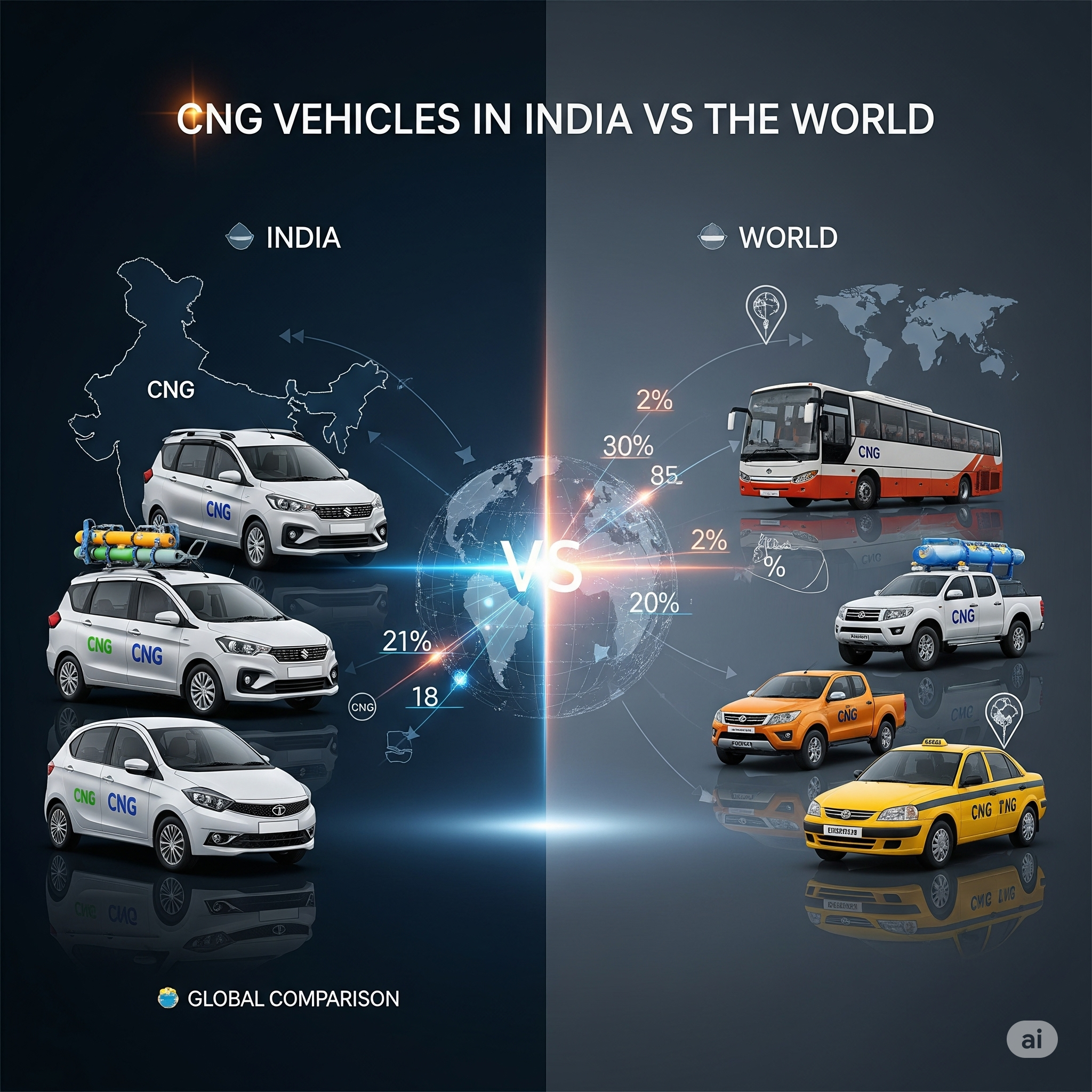Introduction
Compressed Natural Gas (CNG) has emerged as a cleaner and cost-effective alternative to conventional fuels like petrol and diesel. Its use reduces greenhouse gas emissions, lowers particulate matter, and provides an economically viable option for consumers, particularly in urban transport and fleet vehicles. While India has witnessed a rapid adoption of CNG vehicles in the last two decades, other countries have followed varied trajectories based on resource availability, infrastructure, and policy support. This article examines the global scenario of CNG vehicle adoption, comparing India’s progress with other nations and exploring future prospects.
1. The Global CNG Landscape
CNG vehicles are widely used in countries with substantial natural gas reserves or where governments have actively promoted cleaner fuels.
1.1 Leading Countries in CNG Adoption
- Argentina: Argentina is a global leader in CNG adoption, with millions of vehicles running on natural gas. Government incentives, coupled with abundant domestic gas reserves, have made CNG a mainstream fuel for private and public transport.
- Iran: Iran has leveraged its rich natural gas resources to convert a substantial portion of its vehicle fleet to CNG. CNG is widely used in taxis, buses, and commercial vehicles to reduce dependency on imported fuels.
- Pakistan: The adoption of CNG in Pakistan has been driven primarily by rising fuel costs. Many urban buses, auto-rickshaws, and private vehicles have been converted to CNG, making it an integral part of the country’s urban mobility.
- Brazil: Brazil focuses on CNG adoption to address urban air pollution and reduce reliance on petrol and diesel. Government policies provide incentives for CNG-compatible vehicles and infrastructure development.
- China: China is gradually expanding its CNG vehicle fleet, primarily in urban buses and taxis. The government promotes CNG usage to curb severe air pollution in major cities.
1.2 Developed Nations
In developed countries, CNG adoption varies:
- United States: CNG is mostly used in commercial fleets and heavy-duty trucks. The passenger vehicle market for CNG is limited due to scarce refueling infrastructure and competition from electric vehicles.
- European Union: Nations like Italy and Germany have adopted CNG for public transport and commercial fleets. However, passenger car adoption is moderate, as electric mobility gains priority in the EU’s decarbonization strategy.
2. CNG Vehicles in India
2.1 Growth and Market Trends
India has emerged as a key market for CNG vehicles, primarily due to environmental concerns and the rising cost of petrol and diesel. The growth trajectory is characterized by:
- Urban Adoption: Cities such as Delhi, Mumbai, and Bengaluru have seen extensive adoption of CNG in public buses, taxis, and private vehicles.
- Fuel Cost Advantage: The lower price of CNG compared to petrol and diesel makes it attractive for fleet operators and individual consumers.
- Environmental Benefits: CNG vehicles emit fewer pollutants, including carbon monoxide, hydrocarbons, and particulate matter, contributing to improved urban air quality.
2.2 Government Policies and Initiatives
Several government measures have facilitated CNG adoption in India:
- City Gas Distribution (CGD) Networks: Expansion of CGD networks ensures accessibility of CNG fuel in urban and semi-urban areas.
- Incentives and Tax Benefits: Manufacturers and consumers receive incentives for adopting CNG-compatible vehicles.
- FAME (Faster Adoption and Manufacturing of Hybrid and Electric Vehicles) Program: Though primarily focused on electric mobility, FAME also encourages cleaner fuel adoption, including CNG.
2.3 Infrastructure Development
- Refueling Stations: India has established over 3,000 CNG refueling stations, primarily in metropolitan areas. Continuous expansion is underway to support rural and semi-urban adoption.
- Public Transport Integration: Cities like Delhi have converted their entire bus fleets to CNG, significantly reducing urban air pollution.
- Private Vehicles: Automakers now offer a variety of CNG variants, catering to individual consumer demand.
3. Comparative Analysis: India vs the World
3.1 Adoption Metrics
While India’s CNG adoption is growing rapidly, other nations have distinct adoption patterns:
| Country | CNG Vehicles (millions) | Market Share (%) | Primary Usage |
|---|---|---|---|
| Argentina | 2.1 | 35 | Private & public |
| Iran | 1.8 | 25 | Public & taxis |
| Pakistan | 1.3 | 20 | Urban transport |
| India | 1.1 | 15 | Urban & fleet |
| Brazil | 0.9 | 12 | Public & private |
| China | 0.6 | 8 | Buses & taxis |
Note: Figures are approximate and based on latest available data.
3.2 Key Differences
- Infrastructure: Countries like Iran and Argentina have well-established refueling networks, whereas India is still expanding its network outside major cities.
- Government Support: India has significant policy support, but developed nations often rely on environmental regulations and incentives to encourage adoption.
- Vehicle Types: In India, CNG is widely used in both public buses and private vehicles. Globally, heavy-duty and commercial fleets dominate CNG usage, particularly in the U.S. and Europe.
- Fuel Pricing: India benefits from a lower CNG price relative to petrol/diesel, driving consumer adoption. In contrast, countries with subsidized petrol/diesel may have slower uptake.
4. Challenges in India
Despite rapid growth, India faces several hurdles:
- Limited Rural Penetration: CNG refueling stations are concentrated in urban centers, leaving rural consumers with limited access.
- Awareness and Consumer Perception: Many consumers are unaware of the benefits of CNG, or perceive it as less powerful than petrol/diesel.
- Infrastructure Maintenance: High-pressure cylinders and pipelines require regular maintenance to ensure safety.
- Competition from Electric Vehicles: The growing popularity of electric vehicles may slow CNG adoption in the long term.
5. Challenges Globally
Other nations face different challenges:
- Infrastructure Limitations: In the U.S. and parts of Europe, limited refueling stations hinder widespread adoption.
- Policy Fluctuations: Inconsistent government incentives can slow the growth of CNG fleets.
- Technology Competition: Electric and hybrid vehicles are increasingly preferred in developed nations due to zero-emission goals.
- Supply Dependence: Countries without domestic natural gas resources rely on imports, which can affect fuel pricing and adoption rates.
6. Advantages of CNG Vehicles
- Environmental Benefits: Reduced emissions of CO2, NOx, and particulate matter.
- Economic Savings: Lower fuel costs compared to petrol and diesel.
- Engine Longevity: Cleaner combustion reduces engine wear and maintenance costs.
- Safety: CNG is lighter than air and disperses quickly in case of leaks, reducing fire risk.
7. Future Prospects
7.1 India
- Infrastructure Expansion: Continued rollout of refueling stations will enhance adoption, especially in Tier-2 and Tier-3 cities.
- Fleet Modernization: Increasing conversion of public transport and logistics vehicles to CNG.
- Policy Support: Government incentives and subsidies are expected to continue, encouraging both manufacturers and consumers.
7.2 Global Trends
- Technological Innovations: Improvements in cylinder materials, engine efficiency, and leak detection will make CNG vehicles safer and more efficient.
- Integration with Renewable Gas: Blending CNG with biogas or renewable natural gas (RNG) enhances sustainability.
- Electric Vehicle Competition: While EVs are rising, CNG remains a practical alternative in regions with limited electricity infrastructure.
Conclusion
India has emerged as a significant player in the global CNG vehicle market. Although it lags behind countries like Argentina and Iran in terms of fleet size and infrastructure density, its rapid growth, supportive government policies, and cost advantages position it as a key market for alternative fuel vehicles. Globally, CNG continues to serve as a transitional technology, providing cleaner, more affordable mobility solutions while countries expand their electric vehicle and renewable energy initiatives.
The future of CNG vehicles will depend on infrastructure development, policy stability, technological innovation, and consumer awareness, both in India and worldwide. As urban pollution and fuel costs remain pressing concerns, CNG vehicles are likely to maintain a significant role in sustainable transportation for decades to come.




